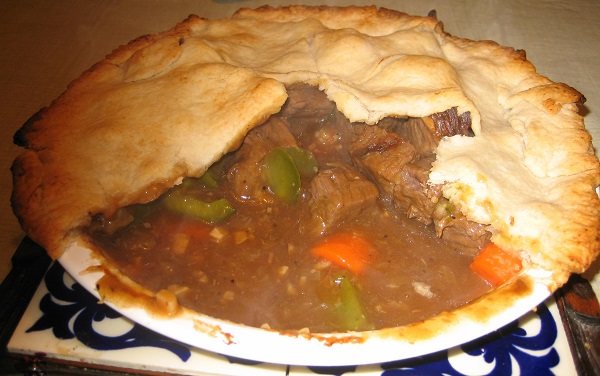Sing a song of six-pence, a pocket full of rye
Four and twenty blackbirds, baked in a pie
When the pie was opened, the birds began to sing.
Now wasn’t that a tasty dish to set before the king!
This article is about meat pies, most of us know them as the frozen “Pot Pie”.
The history of meat pies date far back into antiquity during the Neolithic Period, around 9500 BC. The Greeks used a flour water paste that resembled a pie crust which they fried or cooked under hot coals. Later, the Romans used the crust as a container for the filling and threw the curst away. The Crusaders brought the recipes to Medieval Europe and these recipes were turned into pastries made with lard or butter were originally just containers used for baking, storage, and serving. The crust was too hard to actually eat because they were several inches thick and took hours to cook in a Medieval/Renaissance central hearth or fire pit.
These pastries were known as “coffins/coffyns” which means a box or basket because they were fully encased in a top and bottom crust. Known as “bake metis” these pies were made of the cheaper cuts of beef, pork, venison, lamb, duck, rabbit, or fowl. Often a combination of meats were either broiled or boiled in cauldrons. Next the meat was cut into bite size pieces or made into a meat paste. Later, the Italians and French made a tastier crust.
The Magpie was so commonly used as the main ingredient that these “bake metis” are said to have become known as “Pies/pyes” Often times the pie was baked with a whole “byrdy” (bird) on top of the pie.
In the 1600s, the Pilgrims brought the recipes to the United States. For the settlers, these pies were practical to make because it took less flour and time to make a pie than to make bread, plus the pie was delicious, and fuel efficient. As was done since antiquity, the crust of the pie was used to preserve the food in the cold winter months.
You can cook these meat pies on a wood burning stove, in a fire pit or fireplace with a Dutch oven. Place hot coals under and on top of the Dutch oven. Just remember that baking in a Dutch oven with coals, the heat will usually be more from the top than the bottom. Use a 3:1 lid to bottom ratio for placing your coals. Check often and remove or replace coals as needed.
To make this meal easy, use frozen vegetables and buy two readymade pie crusts. Stir and mix the mixture together with gravy to make it wet and pour into the pie shell. Bake in the Dutch oven or regular oven at 350 for 35 minutes to an hour. Cook until the crust is a nice golden brown. Another way to cook these pies is to make a pasty by cutting the pie dough into circles. Place the filling in the center and fold over sealing the edges of the pie and poke with a fork to allow steam to vent. Either bake in the oven or Dutch oven at 350 for 30-45 minutes or fry. Both ways are yummy! These pies are great to freeze before cooking and they are also great for lunches as they even taste good cold.
Medieval Meat Pie
- 1 1/2 lbs. beef, rabbit, chicken, pork or venison (or any combination of meats)
- 1 cup grated cheese
- 1/2 cup currants or raisins (or any dried fruit)
- 4 egg yolks
- 1/4 teaspoon ground cardamom, cinnamon, nutmeg, black pepper, and salt
- 1/2-1 cup meat broth
- 1 dash wine or stout beer
- 2- 9 inch pie shells for bottom and top of pie
Broil the meat till very rare, but cooked through. Cut it into small cubes and mix with other ingredients. For the broth, just add enough to make the mixture a little wetter. Pour the mixture into the pie shell. Put on the top crust making sure to seal the edges, cut slits in the top. Bake at 350 for 45 minutes to an hour, until the shell is golden brown. Makes 6-8 slices, and can be served at any temperature.
Did you know that George Washington liked steak and kidney pie?
Wish I had pictures to show you but we ate our pie before I thought to take a photo! Make one of these savory pies and let us know how you liked it.
http://en.wikipedia.org/wiki/Meat_pie
http://en.wikipedia.org/wiki/Pasty
Susan’s BIO
When Susan and her husband Rob Norgren are not traveling in their bus conversion they are having fun discovering new skills and practicing for the day they might use them for any emergency or disaster. Susan has been a guest on numerous news shows such as KOB-TV Good Morning New Mexico http://www.kob.com/article/stories/S3365759.shtml?cat=11121#.VFWRJMnkqjt as well as various radio shows and in the January/February 2014 issue of Focus on Women Magazine, Susan was featured on the cover of the magazine. http://www.focusonwomenmagazine.com/pdf/2014_jan.html
Her book “When the Golden Egg Cracks” is not about doomsday and Armageddon, instead it is a book offering knowledge and the solutions to remain healthy, safe and happy now and in a post-collapsed world scenario. http://amzn.to/1c3B9S1 Check out her blog: http://www.susanpsychicmedium.com/blog/category/when-the-golden-egg-cracks-2/ and website at http://www.susanpsychicmedium.com

Leave a Reply